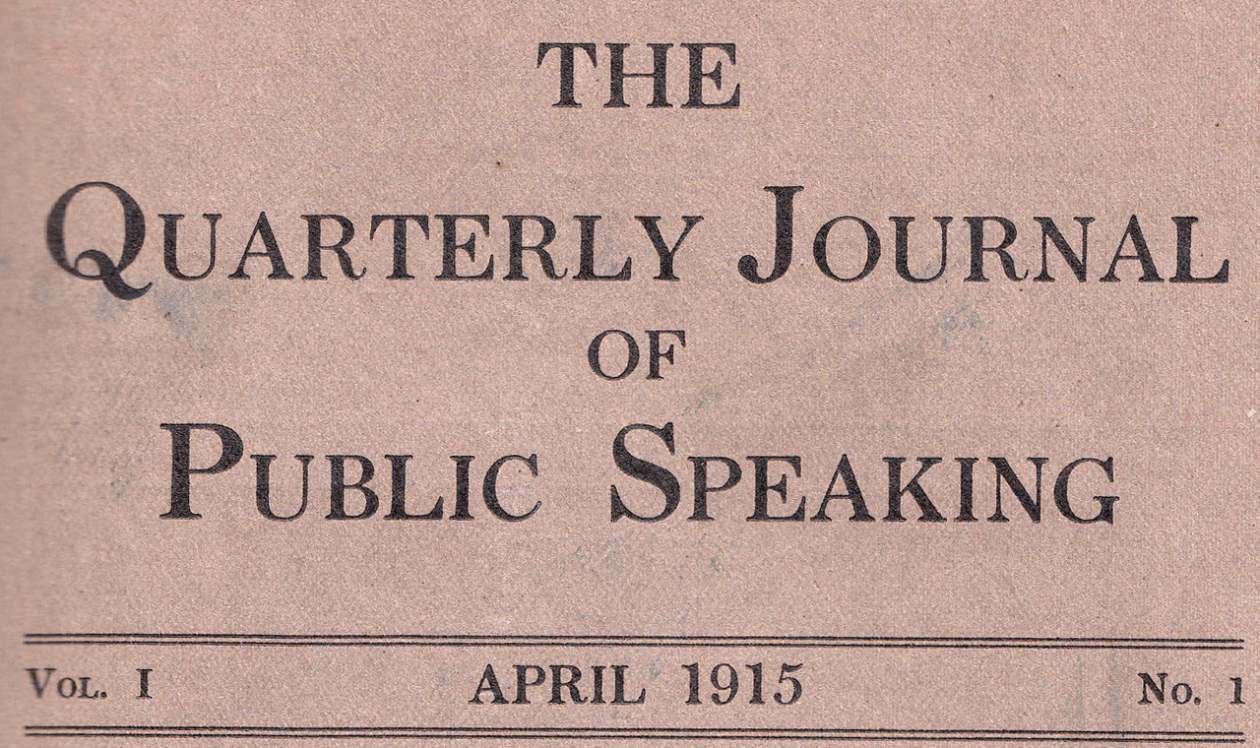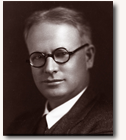
NCA’s long and rich history reflects shifts in the priorities and interests of Communication scholars, researchers, and professionals. Various name changes reflect the association’s evolution over more than a century.
The association’s founding in 1914 arose from a dispute within the ranks of the National Council of Teachers of English. Dissatisfied over the diminished importance of speech instruction within departments of English, seventeen speech teachers withdrew from the council to form the National Association of Academic Teachers of Public Speaking (NAATPS). That initial interest in public speaking and persuasion still remains fundamental to the Communication discipline.

The association’s first president was James M. O’Neill (left) from the University of Wisconsin. The first convention, hosted in Chicago in 1915, attracted 60 members and featured 16 people on the program. Annual dues were $2.00, and the cost of the convention was $1.00.
NAATPS inaugurated its first publication, The Quarterly Journal of Public Speaking, within a year of its founding. In 1917, the publication’s name changed to Quarterly Journal of Speech Education, and “Education” was dropped in 1928. It has retained that name ever since.
In a harbinger of the association’s future focus, President O’Neill’s first stated goal was “encouragement of research,” followed by “publishing”:
First, we wish to promote and encourage research work in various parts of the field of public speaking; we wish to encourage and assist individuals and committees with who will undertake by scientific investigation to discover the true answer to certain problems. . . . Our second main purpose is to publish The Quarterly Journal [of Public Speaking]. Through this periodical we hope to distribute to all the profession the results of research investigation.
NAATPS had the foresight to create a Research Committee, which faced the formidable task of moving the Communication discipline toward research when it had been almost entirely focused on performance instruction. “A real need of a bibliography of books on public speaking and kindred subjects can hardly be doubted,” one committee statement noted. While the association has adapted to changes in the discipline over the years, research and publishing have remained central to its mission.
Interest in the association was robust. By 1916, it had 160 members, and that number grew to 700 by 1920.
At the same time, universities pushed to achieve greater recognition for the discipline, with an increase in the formation of departments of speech. The University of Iowa and the University of Wisconsin were the first two speech departments to offer courses toward the Ph.D. in 1921.
With membership having increased to 910 by 1923, the organization underwent its first name change, to the National Association of Teachers of Speech (NATS). New services, including job placement, were added. In 1934, NATS began publishing Speech Monographs (now titled Communication Monographs), and membership topped 2,000.
During this period, the Communication discipline shifted toward a focus on rhetoric. Both rhetorical theory and criticism came under the purview of teachers and researchers in speech, as the discipline of English became interested in literary criticism. The Communication discipline also was influenced by the social and intellectual climate of the time.
From the late 1920s to the 1940s, the Communication discipline sought to integrate contemporary thought into its teaching and research. Some of the most prominent influences came from the psychology theories of Sigmund Freud and the social adjustment theories of John Dewey. Speech scholars focused on the study of personality and its relation to speech, envisioning the classroom as a laboratory for personality improvement.
During World War II, however, the discipline turned away from its focus on personality improvement. After the war, younger speech scholars turned to other psychological topics for their research.
In 1946, the association again changed its name to the Speech Association of America (SAA) and officially incorporated under this name five years later. In January 1952, SAA launched its third quarterly publication, Speech Teacher (now Communication Education), which was geared toward the classroom teacher. Within two years, the publication had a circulation of more than 2,000, including 175 library subscriptions.
Until 1963, the association’s national headquarters was located on or near the home campus of the executive secretary, who served for a three-year period. SAA then moved the headquarters from the Indiana University campus to New York City, appointing its first executive director and creating full-time administrative positions to facilitate operations.
Fluctuations in membership and fractionalization of academic specialties within the discipline in the 1960s led to growing support for a reexamination of the association’s structure and governance. A new constitution was drafted by an appointed Constitutional Conference and a Committee on Structure, and the constitution became effective on July 1, 1970, the same year the organization chose a new name: the Speech Communication Association (SCA).
With professional offices and a national headquarters, the SCA grew rapidly over the next two decades. A key part of this growth was expansion of basic services, including the development of new publications to address changes in the field. These included the Journal of Applied Communication (now the Journal of Applied Communication Research) (1973), Critical Studies in Mass Communication (now Critical Studies in Media Communication) (1984), and Text and Performance Quarterly (1989). SCA also expanded its conference and awards programs. At the same time, the association increasingly responded to a multitude of issues arising from an increasingly complex society and the influence of the electronic age.
In 1997, the organization underwent yet another name change to become the National Communication Association. It outgrew its Manhattan headquarters and moved to Annandale, VA, just outside of Washington, DC.
During that time, President James W. Chesebro, Indiana State University, argued that international recognition should influence Communication theory, research, and practices – within both the discipline and the association. Under his leadership, NCA became more of an international organization, hosting its first international conference in Mexico City in 1997. Also during that year, the association was accepted into the American Council of Learned Societies, a federation of scholarly organizations that advances the humanities and related social sciences.
In 1999, the national office moved from Virginia to Washington, DC. In 2001, the association launched the Review of Communication and then in 2008, launched the Journal of International and Intercultural Communication.
Today, NCA maintains its proud tradition as a Communication leader, boasting a large membership of educators, practitioners, and students in every state.
| 1915 | H. B. Gislason, University of Minnesota, Secretary G. N. Merry, University of Iowa, Treasurer |
| 1916 | P. S. Kingsley, University of Denver, Secretary H. S. Woodward, Western Reserve University, Treasurer |
| 1917 | Sherman Conrad, Culver Military Academy, Secretary H. S. Woodward, Treasurer |
| 1918-1919 | L.R. Sarett, University of Illinois, Secretary C.H. Thurber, Purdue University, Treasurer |
| 1920 | Bess Baker, Maywood (Ill.) High School, Secretary R. K. Immel, University of Michigan, Treasurer |
| 1921 | Margaret Stedman, West Virginia University, Secretary R. K. Immel, University of Michigan, Treasurer |
| 1922 | Lousene Rousseau, Western Michigan Normal College, Secretary R. K. Immel, University of Michigan, Treasurer |
| 1923 | Henrietta Prentiss, Hunter College, Secretary R. K. Immel, University of Michigan, Treasurer |
| 1924 | Frederica V. Shattuck, Iowa State College, Secretary R. K. Immel, University of Michigan, Treasurer |
| 1925 | J.Walter Reeves, Peddie Institute, Secretary H.L. Ewbank, Albion College, Treasurer |
| 1926 | Ottilie T. Seybolt, Smith College, Secretary H.L. Ewbank, Albion College, Treasurer |
| 1927 | Louis Eich, University of Michigan, Secretary H.L. Ewbank, Albion College, Treasurer |
| 1928-1930 | H.L. Ewbank, University of Wisconsin |
| 1931-1939 | G. E. Densmore, University of Michigan |
| 1940-1945 | R.L. Cortright, Wayne State University |
| 1945-1951 | Loren Reid, University of Missouri |
| 1951-1954 | Orville Hitchcock, University of Iowa |
| 1954-1957 | Waldo W. Braden, Louisiana State University |
| 1957-1960 | Owen M. Peterson, Louisiana State University |
| 1960-1963 | Robert C. Jeffrey, Indiana University |
| 1963-1988 | William Work, NCA National Office |
| 1988-2004 | James Gaudino, NCA National Office |
| 2004-2009 | Roger Smitter, NCA National Office |
| 2009-2016 | Nancy Kidd, NCA National Office |
| 2017 | Paaige Turner, NCA National Office |
| 2018-2021 | Trevor Parry-Giles, NCA National Office |
| 2022-2023 | Shari Miles-Cohen, NCA National Office |
| 2024-Present | Justin Danowski, NCA National Office |

